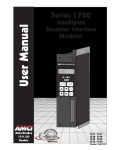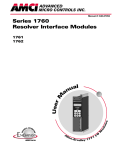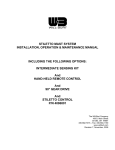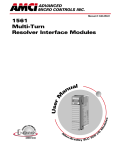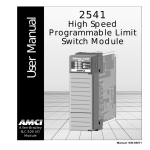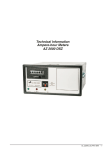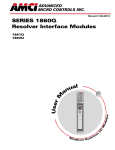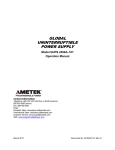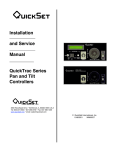Download AMCI 1761H User manual
Transcript
User Manual 1761H Intelligent Resolver Interface Module Allen-Bradley 1771 I/O Module Manual: 940-57061 General Information Important User Information The products and application data described in this manual are useful in a wide variety of different applications. Therefore, the user and others responsible for applying these products described herein are responsible for determining the acceptability for each application. While efforts have been made to provide accurate information within this manual, AMCI assumes no responsibility for the application or the completeness of the information contained herein. UNDER NO CIRCUMSTANCES WILL ADVANCED MICRO CONTROLS, INC. BE RESPONSIBLE OR LIABLE FOR ANY DAMAGES OR LOSSES, INCLUDING INDIRECT OR CONSEQUENTIAL DAMAGES OR LOSSES, ARISING FROM THE USE OF ANY INFORMATION CONTAINED WITHIN THIS MANUAL, OR THE USE OF ANY PRODUCTS OR SERVICES REFERENCED HEREIN. Throughout this manual the following two notices are used to highlight important points. WARNINGS tell you when people may be hurt or equipment may be damaged if the procedure is not followed properly. CAUTIONS tell you when equipment may be damaged if the procedure is not followed properly. No patent liability is assumed by AMCI, with respect to use of information, circuits, equipment, or software described in this manual. The information contained within this manual is subject to change without notice. Standard Warranty ADVANCED MICRO CONTROLS, INC. warrants that all equipment manufactured by it will be free from defects, under normal use, in materials and workmanship for a period of [1] year. Within this warranty period, AMCI shall, at its option, repair or replace, free of charge, any equipment covered by this warranty which is returned, shipping charges prepaid, within one year from date of invoice, and which upon examination proves to be defective in material or workmanship and not caused by accident, misuse, neglect, alteration, improper installation or improper testing. The provisions of the "STANDARD WARRANTY" are the sole obligations of AMCI and excludes all other warranties expressed or implied. In no event shall AMCI be liable for incidental or consequential damages or for delay in performance of this warranty. Returns Policy All equipment being returned to AMCI for repair or replacement, regardless of warranty status, must have a Return Merchandise Authorization number issued by AMCI. Call (860) 585-1254 with the model number and serial number (if applicable) along with a description of the problem. A "RMA" number will be issued. Equipment must be shipped to AMCI with transportation charges prepaid. Title and risk of loss or damage remains with the customer until shipment is received by AMCI. 24 Hour Technical Support Number 24 Hour technical support is available on this product. For technical support, call (860) 5837271. Your call will be answered by the factory during regular business hours, Monday through Friday, 8AM - 5PM EST. During non-business hours an automated system will ask you to enter the telephone number you can be reached at. Please remember to include your area code. The system will page one of two engineers on call. Please have your product model number and a description of the problem ready before you call. ADVANCED MICRO CONTROLS INC. About This Manual Introduction There are now a variety of 1700 Series Intelligent Resolver Interface Modules for AllenBradley 1771 I/O to fit your application. These modules accept one, two, three, or four resolver inputs and convert the resolvers analog signals into digital position and tachometer data that is transmitted to the processor over the backplane. The series are broken down into the 1730 modules that are 10-bit, single turn, resolver interface modules; the 1740 modules that are 13bit, single turn, resolver interface modules; and the 1760 modules that are multi-turn resolver interface modules which offer 12-bit resolution per turn. This manual explains the operation, installation, programming, and servicing of the 1761H module. The factory can send you, upon request, manuals for the other modules in this series. It is strongly recommended that you read the following instructions. Please call the factory if there are any unanswered questions after reading this manual. An applications engineer will be available to assist you. AMCI is a registered trademark of Advanced Micro Controls Inc. The AMCI logo is a trademark of Advanced Micro Controls Inc. PLC-5 is a registered trademark of Allen-Bradley Company. Viton is a registered trademark of E.I. DuPont This product is licensed under patents and proprietary technology of Allen-Bradley Company, Inc. Allen-Bradley Company, Inc. does not warrant or support this product in any manner. Manuals at AMCI are constantly evolving entities. Your questions and comments on this manual and the information it contains are both welcomed and necessary if this manual is to be improved. Please direct all comments to: Technical Documentation, AMCI, 20 Gear Drive, Plymouth Industrial Park, Terryville CT 06786, or fax us at (860) 584-1973. Revision Record The following is the revision history for this manual. In addition to the information listed here, revisions will fix any known typographical errors and clarification notes may be added. This manual, 940-57061, is the first release of the electronic manual and corresponds to the printed manual 940-07061. The table of contents is removed from this file and incorporated as bookmarks in the PDF file. This revision incorporates the latest transducer drawing for the HTT-20-(x) and the HTT-400-180. The manual corresponds to software revision 1, checksum DCCA for the 1761H. The software can only be used on revision H and higher of the main PC board. The software adds backplane programmability, Autotech compatibility, to the module and incorporates several features into the 1761H that were only available as options before. These new features are described in chapter 1: 1761H Introduction. 20 Gear Drive, Plymouth Ind. Park, Terryville, CT 06786 Tel: (860) 585-1254 Fax: (860) 584-1973 3 About This Manual Notes 4 ADVANCED MICRO CONTROLS INC. Chapter 1 Introduction This chapter serves as an introduction to the 1761H module. It highlights potential applications, compatible transducers, and all of the modules’ features, including those added since the last revision. Overview The 1761H module is the Allen Bradley 1771 I/O compliant card that converts resolver signals to digital multiturn position and tachometer data that can be reported over the backplane using either block or single transfers. This module eliminates the separate resolver decoder box, PLC input card, and associated wiring needed to bring the digital data into a PLC. Like an absolute optical encoder, a resolver is a single turn absolute sensor that converts an angle into electrical signals. However, this is where the similarities end. The resolver is an analog device that does not contain sensitive components such as optics and electronics that may be damaged by severe environmental conditions. Also, the position resolution of a resolver is limited only by the electronics that decode its signals. The module can produce an absolute 20 bit multi-turn position value with a maximum 12 bits (4,096 counts) per turn when an AMCI transducer is connected to it. The transducer that connects to the 1761H contains two resolvers. These resolvers are geared together in a vernier arrangement. The module decodes the separate resolvers and combines their positions into an absolute multi-turn position. The 1761H accepts a single dual-resolver transducer. Figure 1.1 1761H Module A 1761H application generally falls into one of two categories. hýRotary Application - The resolver position directly correlates to an angular position on the machine. One example is monitoring a rotary table by attaching a multi-turn monitor and control such functions as motor braking to stop the table at its stations. hýLinear Application - The resolver position correlates to a physical length. One example is a packaging machine where the transducer completes multiple turns for each product. Here the transducer position is used to control when glue is applied or when the package is cut to length. Another example of a multi-turn application is monitoring the position of a load on either a track or ball screw such as a press shut height monitor. In this type of application, linear position is translated to rotary position through either a wheel or gearing. The transducer completes several rotations in order to travel the complete distance. AMCI also has a line of cable reel transducers for use in some linear applications. A cable reel transducer has a stranded stainless steel cable wrapped around a spring loaded drum. As the cable is pulled out of the transducer, the drum rotates, which in turn rotates the internal resolvers. The cable is retracted by the force of the drums' spring. Distances of up to forty-five feet can be measured with these transducers. 20 Gear Drive, Plymouth Ind. Park, Terryville, CT 06786 Tel: (860) 585-1254 Fax: (860) 584-1973 5 Chapter 1 Introduction Overview (continued) The module has Setup Parameters that allow you to scale and adjust the position and tachometer data. Additional parameters allow you to define the type of attached transducer and the digital format of the position data. To maintain compatibility with past versions of the module, some of these parameters can be set with jumpers. Most of the parameters can be programmed over the backplane using block transfers. Using single transfers, a limited number of parameters can be programmed over the backplane. Since revision H of the PC board, the1761H module directly supports Autotech transducers. The module does this by automatically adjusting the reference voltage to the Autotech level when the Resolver Type parameter is changed from the backplane. Brushless Resolver Description The brushless resolver is unsurpassed by any other type of rotary position transducer in its ability to withstand the harsh industrial environment. An analog sensor that is absolute over a single turn, the resolver was originally developed for military applications and has benefited from more than 50 years of continuous use and development. The resolver is essentially a rotary transformer with one important distinction. The energy coupled through a rotary transformer is not affected by shaft position whereas the magnitude of energy coupled through a resolver varies sinusoidally as the shaft rotates. A resolver has one primary winding, the Reference Winding, and two secondary windings, the SIN and COS Windings (See figure 1.2, Resolver Cut Away View). The Reference Winding is located in the rotor of the resolver, the SIN and COS Windings in the stator. The SIN and COS Windings are mechanically displaced 90 degrees from each other. In a brushless resolver, energy is supplied from the Reference Winding to the rotor by a rotary transformer. This eliminates brushes and slip rings in the resolver and the reliability problems associated with them. In general, the Reference Winding is excited by an AC voltage called the Reference Voltage (VR). (See figure 1.3, Resolver Schematic). The induced voltages in the SIN and COS Windings are equal to the value of the Reference Voltage multiplied by the SIN or COS of the angle of the input shaft from a fixed zero point. Thus, the resolver provides two voltages whose ratio represents the absolute position of the input shaft (SIN θ / COS θ = TAN θ, where θ = shaft angle). Because the ratio of the SIN and COS voltages is considered, any changes in the resolvers’ characteristics, such as those caused by aging or a change in temperature are ignored. Rotary Transformer S1 (Red) COS Winding Reference Winding VC = VR COSθ S3 (Blk) R1 (Red/Wht)* SIN Winding VR R2 (Blk/Wht) Rotary Transformer *(Wire Color) S2 (Yel) θ VS = VR SINθ S4 (Blu) SIN and COS Windings Figure 1.2 Resolver Cut away View 6 Figure 1.3 Resolver Schematic ADVANCED MICRO CONTROLS INC. Chapter 1 Introduction AMCI Compatible Transducers Table 1.2 lists the AMCI transducers compatible with the 1761H module. Model Shaft Mount Turns Comments HTT-20-100 HTT-20-180 0.625" 0.625" Front Front HTT-20-1000 0.625" Front HTT-20-1800 0.625" Front HTT425-Ann-100† 0.250" Motor HTT425-Mnn-100† 10 mm Motor HTT425-Fnn-100† 0.625" Front HTT425-Tnn-100† 0.625" Foot HTT400-180 0.625" Front HTTCR-9n-100 0.047" Cable Foot 100 180 NEMA 13 heavy duty transducer NEMA 13 heavy duty transducer HTT-20-100 w/ additional 10:1 gearing on input 1,000 shaft. HTT-20-180 w/ additional 10:1 gearing on input 1,800 shaft. A-B Series 1326 motor mount transducer. 100 “nn” in part number defines connector style. Universal motor mount. Requires adapter plate. 100 “nn” in part number defines connector style. 100 NEMA 4X, HTT-20-100 w/ Viton ® shaft seal. “nn” in part number defines connector style. 100 NEMA 4X, HTT-20-100 w/ Viton shaft seal. “nn” in part number defines connector style. 180 NEMA 4, HTT-20-180. Bolt–in replacement for Autotech RL210 transducers. 540" Cable Reel Transducer, 540" span, 0.003" max. resolution, 45 ft stranded stainless cable standard. † A 1,000 turn version is also available. Table 1.1 Compatible AMCI Transducers Each transducer contains two resolvers. The first resolver, called the fine resolver, is attached directly to the input shaft with a flexible coupler. The second resolver, called the course resolver, is geared to the fine. This gear ratio, either 99:100 or 179:180 determines the total number of turns the transducer can encode. At the mechanical zero of the transducer the electrical zeros of the two resolvers are aligned. See Figure 1.4A. After one complete rotation, the zero of the course resolver lags behind the zero of the fine by one tooth, either 1/100 or 1/180 of a turn. After two rotations the lag is 2/100 or 2/180. See Figures 1.4B and 1.4C. After 100 or 180 turns, the electrical zeros of the resolvers are realigned and the multi-turn cycle begins again. FINE COURSE 0 0 FINE COURSE 0 0 FINE COURSE 0 0 A B C Mechanical Zero After One Turn After Two Turns Figure 1.4 Resolver Alignment in Multi-turn Transducers The fine resolver yields the absolute position within the turn directly. Using a proprietary algorithm, the module determines the number of turns completed by the difference in positions of the two resolvers. The absolute Multi-turn position is then calculated as ((number of turns completed * counts per turn) + fine resolver position). The 1,000 and 1,800 turn transducers have a 10:1 gear ratio between the input shaft and the resolvers. Therefore they can encode ten times the number of turns but at a tenth of the resolution. 20 Gear Drive, Plymouth Ind. Park, Terryville, CT 06786 Tel: (860) 585-1254 Fax: (860) 584-1973 7 Chapter 1 Introduction Other Compatible Transducers In addition to AMCI transducers, the 1761H module now directly support Autotech multiturn transducers. The Autotech models supported are: hýAll SAC-RL210-G128 Transducers. (Size 40, NEMA 13) Autotech also manufactures SAC-RL210-G64 transducers. These transducers are not supported by AMCI. You select between AMCI and Autotech transducers over the backplane from the processor. The module then sets the reference voltage according to your selection. When using Autotech transducers, only 10 bit (1024 counts) per turn resolution is supported. AMCI’s HTT400 -180 is a direct bolt-in replacement for the Autotech RL210. AMCI strongly suggests using this transducer instead of the Autotech RL210. Programmable Number of Turns The maximum number of turns a transducer can encode is fixed by the gearing inside of it. However, the 1761H has the ability to divide this maximum number of turns into smaller multiturn cycles. The module does this without loss of absolute position within the smaller cycle. An example of this feature is shown in figure 1.5. It shows how the 180 turn mechanical cycle of an HTT-20-180 can be broken down into three electronic cycles of sixty turns each. The 180 turn cycle could also be broken down into sixty cycles of three turns each. HTT-20-180 180 Turn Cycle Mechanical fixed by internal gearing. Electronic 60 Turn Cycle Electronic 60 Turn Cycle Electronic 60 Turn Cycle Figure 1.5 Programmable Number of Turns Example You program the number of turns you want the module to decode over the backplane. hýWhen using a 100 turn transducer, the number of turns is programmable to 1, 2, 4, 5, 10, 20, 25, 50, or 100. hýWhen using a 180 turn transducer, the number of turns is programmable to 1, 2, 3, 4, 5, 6, 9, 10, 12, 15, 18, 20, 30, 36, 45, 60, 90, or 180. hýWhen using a SAC-RL210-G128, the number of turns is programmable to 1, 2, 4, 8, 16, 32, 64, or 128. To the 1761H, the HTT-20-1,000 and HTT-20-1,800 transducers appear to be HTT-20-100 and HTT-20-180 transducers. Therefore, when using the 1,000 or 1,800 transducers, program the Number of Turns using the 100 or 180 turn values above. The actual Number of Turns that must be completed will be ten times (10x) the programmed value. 8 ADVANCED MICRO CONTROLS INC. Chapter 1 Introduction The remainder of this chapter introduces the many programmable features of the 1761H module. It also introduces backplane programming concepts that allows you to control the module from the processor. Programmable Parameters Programmable parameters are stored in the modules nonvolatile memory. Therefore, you do not have to configure the module after every power up. Prior to hardware revision H of the module, the nonvolatile memory was EEPROM. This technology has the advantage of retaining programmed values for over 100 years. Its disadvantage is its limited number of write cycles, approximately ten thousand, before the memory will begin to fail. With revision H, the nonvolatile memory has been changed to battery backed, non-volatile, static RAM (nvRAM). The battery in the nvRAM is rated for ten years but the nvRAM has an unlimited number of write cycles. The nvRAM has the additional advantage of significantly decreasing the time needed to store new parameter values. Count Direction This new parameter sets the direction of transducer shaft rotation to increase the position count. If the transducer cable is wired as specified in this manual and the count direction is set to positive, the position count will increase with clockwise rotation (looking at the shaft). If the count direction is set to negative, the position count will increase with counter-clockwise rotation. hýThe Count Direction default value is positive. It is also possible to reverse the count direction by reversing four wires in the transducer cable. If you are installing this module either as a replacement for an older module or on a machine that is a copy installation of a previous system, you will probably not need to set this parameter. Once the machine is setup, you can easily change this parameter if the position is increasing in the wrong direction. Resolver Type The Resolver Type parameter is programmable from the backplane and makes Autotech 128 turn transducers compatible with the 1761H module. hýThe Resolver Type default value is AMCI. The module can then be programmed to use Autotech transducers. Transducer Type This parameter specifies the type of transducer attached to the input channel. The module needs this information in order to combine the positions of the two resolvers inside the transducer into one multi-turn position. This parameter is selected by the J2 jumper on the circuit board and is not programmable from the processor. When the Resolver Type bit is set to AMCI, the Transducer Type parameter can be set to: hý100/1,000 hý180/1,800 Turn transducer (default value) Turn transducer When the Resolver Type bit is set to Autotech, the Transducer Type parameter is fixed. It specifies a 128 turn transducer only. The 64 turn transducers are not supported by AMCI. 20 Gear Drive, Plymouth Ind. Park, Terryville, CT 06786 Tel: (860) 585-1254 Fax: (860) 584-1973 9 Chapter 1 Introduction Programmable Parameters (continued) Number of Turns The Number of Turns parameter sets the number of turns needed to complete one multi-turn cycle. The values that can be programmed into this parameter is dependent on the value of the Transducer Type parameter. hýWhen using a 100 turn transducer, the number of turns is programmable to 1, 2, 4, 5, 10, 20, 25, 50, or 100. hýWhen using a 180 turn transducer, the number of turns is programmable to 1, 2, 3, 4, 5, 6, 9, 10, 12, 15, 18, 20, 30, 36, 45, 60, 90, or 180. hýWhen using a SAC-RL210-G128, the number of turns is programmable to 1, 2, 4, 8, 16, 32, 64, or 128. To the 1761H, the HTT-20-1,000 and HTT-20-1,800 transducers appear to be HTT-20-100 and HTT-20-180 transducers. Therefore, when using the 1,000 or 1,800 transducers, program the Number of Turns using the 100 or 180 turn values above. The actual Number of Turns that must be completed will be ten times (10x) the programmed value. The default value of this parameter is equal to the value of the Transducer Type Parameter. Changing the Transducer Type parameter resets the Number of Turns to its default value. Full Scale Count The Full Scale Count parameter specifies the number of counts over the programmed number of turns. AMCI Transducers hýDefault hýRange value is (Number of Turns * 4096) if 100 or 180 turn transducer is 2 to (Default Value) Autotech Transducers hýDefault hýRange value is (Number of Turns * 1024) is 2 to (Default Value) To the 1761H, the HTT-20-1,000 and HTT-20-1,800 transducers appear to be HTT-20-100 and HTT-20-180 transducers. Therefore, when using the 1,000 or 1,800 transducers, note that the actual Number of Counts per turn is one tenth (1/10th) the programmed value. Changing the Transducer Type parameter resets the Full Scale Count to its default value. Backplane Programming When a 1761H module is configured to use block transfers, it is programmed using data sent to it with block transfer writes. All block transfer writes are four words long. The first word of the block transfer write is called the Command Word. The four least significant bits of this word define what programming data is being transferred to the module . 10 ADVANCED MICRO CONTROLS INC. Chapter 2 Installation This chapter gives information on installing AMCI transducers. This includes information on transducer mounting, shaft loading, and cable installation. Information on interfacing Autotech transducers is also included. Power Requirements The 1761H module draws power from the I/O chassis +5Vdc supply. The maximum current draw is dependent on the number of transducer channels and is given in the table below. Add this to the power requirements of all other modules in the chassis when sizing the chassis power supply. Model Number 1761H Maximum Current Draw 350 mA Table 2.1 Backplane Current Draw Module Configuration Figure 2.1 shows the location of the configuration jumpers on the 1761H module .When shipped from the factory, all jumpers are installed. In order to access the J3-1 and J3-2 jumpers, you must remove the left side panel. Jumper J3-3 is not used in this module. It is strongly recommended that any modification to the J3 jumpers be made in a ESD safe environment. The default configuration is: 180/1,800 Turn Transducer, Binary Position Data, Block Transfer. Figure 2.1 Jumper Locations Jumper J2: Installed: 180/1800 Turn Transducer U29 Removed: 100/1000 Turn Transducer It is Strongly recommended that any modifications to the J3 Jumpers be made in an ESD safe environment to avoid damaging the module through electrostatic discharge. J3 C106 U18 U17 Jumper J3-3: Not Used Jumper J3-2: Installed: BINARY Position Data Removed: BCD Position Data Jumper J3-1: Installed: Block Transfer Removed: Single Transfer 20 Gear Drive, Plymouth Ind. Park, Terryville, CT 06786 Tel: (860) 585-1254 Fax: (860) 584-1973 J3 U19 R23 R22 R21 11 Chapter 2 Installation Installing the Module Remove system power before removing or installing any module in an I/O chassis. Failure to observe this warning may result in damage to the module's circuitry and/or undesired operation with possible injury to personnel. Keying Bands Plastic keying bands can be inserted into the top backplane connector to prevent the insertion of other modules. hýPins 28 and 30 hýPins 32 and 34. Transducer Specifications HTT-20, HTT-400, HTT425-F, HTT425-T Transducers HTT425 Motor Mount Transducers Shaft Diameter ........ 0.625" Shaft Diameter ........ 0.250" or 10mm Shaft Loading .......... Radial: 400 lbs. max. Axial: 200 lbs. max. Shaft Loading .......... Radial: 40 lbs. max. Axial: 20 lbs. max. Starting Torque ....... 8 oz.in. @ 25° C Starting Torque ....... 1.5 oz.in. @ 25° C 2 Moment of Inertia ... 20 oz-in-sec Enclosure ................ HTT-20: NEMA 13 HTT400:NEMA 4 HTT425: NEMA 4X Moment of Inertia ... 4 oz-in-sec2 Enclosure ................. NEMA 4 When properly installed Environmental (All Transducers) Operating Temp -20 to 125°C Shock 50G’s for 11 mSec Vibration 5 to 2000 Hz @ 20 G’s Table 2.2 Transducer Specifications Transducer Mounting All AMCI resolver based transducers are designed to operate in the industrial environment and therefore require little attention. However, there are some general guidelines that should be observed to ensure long life. hýLimit transducer shaft loading to the following maximums: Radial Load Axial Load All 0.625" Shafts 100 lbs. (445 N) 50 lbs. (222.4 N) All other Shafts 30 lbs. (133 N) 15 lbs. (66.7 N) Table 2.3 Transducer Bearing Loads hýMinimize shaft misalignment when direct coupling shafts. Even small misalignments produce large loading effects on front bearings. It is recommended that you use a flexible coupler whenever possible. 12 ADVANCED MICRO CONTROLS INC. Chapter 2 Installation Transducer Outline Drawings The appropriate outline drawing is included with the transducer when shipped. The outline drawings of the HTT-20-(x) and HTT-400-180 transducers are also shown below. HTT-20-(x): Anodized/Painted Aluminum Body, 1070 Carbon Steel Shaft, NEMA 4 (x) = 100, 180, 1,000, or 1,800 3.000" (76.20) 2.000" (50.80) 0.500" (12.70) 1.000" (25.40) 0.375" (9.53) 4.00" (101.60) 0.150" (3.81) 0.500" (12.70) 1.25" (31.8) 1.000" 2.000" (25.40) (50.80) 1.1815" (30.010) 1.1807" (29.990) 4.375" (111.13) 0.6247" (15.867) 0.6237" (15.842) 1/4 - 20 UNC-2B 0.50" (12.7) min. depth. Four places Painted Body Anodized Flange 0.70" (17.8) max. Total Clearance of 5.5" (140) needed for removal of mating connector. 1.175" (29.85) MS3102E20-27P Connector ( ) = Dimensions in milimeters Figure 2.2 HTT-20-(x) Outline Drawing HTT-400-180: Anodized Aluminum Body, 1070 Carbon Steel Shaft, NEMA 4 1" NPT Thread 4.00" (101.6) Dia. ± 0.01" (0.3) #10-32 UNF-2B. 0.50" (12.7) min. depth. Four places, 90° apart on 2.50" (63.5) B.C. 6.41" (162) 1/4-20 UNC-2B 0.50" (12.7) min. depth. Four places. 0.55" (14.0) 0.6247" (15.867) 0.6237" (15.842) 1.250" (31.75) 2.000" (50.80) 1.000" (25.40) KEYWAY 1.000" (25.40) 0.1885(4.79) 0.106(2.69) X DEEP X 1.0 (25.4) 0.1895(4.81) 0.108(2.74) 4.27" (108.5) KEY 2.000" (50.80) ( ) = Dimensions in millimeters 0.187(4.75) SQ. X 1.0 (25.4) 0.188(4.78) 1.60" Sq. (40.6) #8-32 Screws, 4 places. Remove to access resolver connections. When re-installing plate, make sure the gasket is seated correctly and not pinched. Figure 2.3 HTT-400-180 Outline Drawing 20 Gear Drive, Plymouth Ind. Park, Terryville, CT 06786 Tel: (860) 585-1254 Fax: (860) 584-1973 13 Chapter 2 Installation Transducer Cable Installation Use the table below to determine the correct cable and connectors for your application. Cables that have been assembled and tested are available from AMCI under the given part number. If you are making your own cables, cable and connectors can be ordered from AMCI. Module AMCI Part # Belden Cable Module Connector Transducer Connector 1761H CTT - (x) 9731 MS-8 MS-20 Table 2.4 Transducer Cable Numbers 1) Resolvers are low voltage devices. If you are using A-B guidelines for cabling installation, treat the transducer cable as a Category 2 cable. It can be installed in conduit along with other low power cabling such as communication cables and low power ac/dc I/O lines. It cannot be installed in conduit with ac power lines or high power ac/dc I/O lines. Refer to the Allen Bradley Programmable Controller Grounding and Wiring Guidelines manual, Publication number 1770-4.1 for more information. 2) The shields of the transducer cable must be grounded at the module only! A grounding clamp will connect the shields to chassis ground. When installing the cable, treat the shield as a conductor. Do not connect the shield to ground at any junction box or the transducer. These precautions will minimize the possibility of ground loops that could damage the module or PLC. Transducer Input Connector Figure 2.4 shows the transducer input connector which has eight contacts and the pinout to industry standard resolver wire designations. The figure also gives the AMCI and Phoenix Contact part numbers for the mating connector. Cabling information for AMCI and Autotech transducers is given above in Transducer Cable Installation. 8 7 6 5 4 3 2 1 FS4 FS1 CS4 CS3 CS1, CS2, FS2, FS3 Shields CR2, FR2 CR1, FR1 hýC – – hýR1/R2 – hýS1/S3 – hýS2/S4 – hýF Course Resolver Fine Resolver Reference Winding COS Winding SIN Winding 8 Pin Mating Connector AMCI Part # MS-8 Phoenix Contact Catalog # MSTB2.5/8ST-5.08 Phoenix Contact Part # 1757077 Figure 2.4 Transducer Input Connector 14 ADVANCED MICRO CONTROLS INC. Chapter 2 Installation Transducer Cable Wiring Diagrams CTT-(x) Wiring Diagram (1761H) Module Connector BELDEN 9731 Cable AMCI Part #: MS-8 Phoenix #: MSTB2.5/8-ST-5.08 17 57 07 7 GRN BLK WHT BLK FS4 FS1 CS4 CS3 CS1, CS2, FS2, FS3 Shields CR2, FR2 CR1, FR1 8 F 7 6 4 3 H YEL BLK 2 1 G BLU BLK 5 D L K J BRN BLK C: Course Resolver F: Fine Resolver M N I SHIELDS E C B A Transducer Connector RED BLK AMCI Part #: MS-20 Bendix #: MS3106A20-27S Grounding Clamp AMCI Part #: GC-1 Mounts on the chassis below the module. Figure 2.5 CTT-(x) Wiring Diagram GC-1 Grounding Clamp GC-1 GROUNDING CLAMP The shield of the transducer cable must be attached to the chassis with a grounding clamp (AMCI part number GC-1). This guarantees a low impedance path to ground for any EMI radiation that may be induced into the cable. The drain wire from the grounding clamp must be connected to pin 3 of the MS-8 Transducer Input Connector. The grounding clamp package includes installation instructions. See Figure 2.6. Figure 2.6 Grounding Clamp Transducer Connector Pinout FINE RESOLVER R1: (RED/WHT) R2: (BLK/WHT) S3: (BLACK) S1: (RED) S2: (YELLOW) S4: (BLUE) COURSE RESOLVER R1: (RED/WHT) R2: (BLK/WHT) S4: (BLUE) S2: (YELLOW) S1: (RED) S3: (BLACK) All of the AMCI transducers that are compatible with the 1761H module have the same connector. Figure 2.7 is the connector pinout to the industry standard wire designations. Figure 2.7 Transducer Connector Pinout 20 Gear Drive, Plymouth Ind. Park, Terryville, CT 06786 Tel: (860) 585-1254 Fax: (860) 584-1973 15 Chapter 2 Installation Autotech Transducer Installation Transducer Mounting The 1761H module directly support Autotech SAC-RL210-G128 transducers. The Autotech SAC-RL210-G64 transducers are not supported by AMCI. Refer to Autotech literature for dimensional drawings and mounting recommendations. Transducer Wiring Table 3.5 is a wiring table for all supported Autotech transducers. The table cross references resolver designations, AMCI wire color, Autotech terminal and connector pin-outs, and Transducer Input Connector pin-out. 1) Autotech CBL-10T22 cable is not supported. Belden 9731 or exact equivalent must be used. 2) Cable drawings for connecting Autotech transducers are available. If you want a cable drawing instead of using the table, contact AMCI. A drawing will be faxed to you upon request. 9731 Wire Color Resolver Designation SAC-RL210 Terminals SAC-RL210 MS Connector 1761H Connector RED R1 R2 1 2 A B 1 2 R1 R2 1 2 A B 1 2 CS1 CS3 3 5 C E 6 4 CS2 4 D 5 CS4 FS1 FS3 6 7 9 F H L 4 4 8 FS2 8 K 4 FS4 10 M 7 BLK/RED BRN 1 1 BLK/BRN WHT BLK/WHT 1 1 BLK/GRN GRN YEL BLK/YEL 1 BLK/BLU BLU 1 1: Denotes black wire of black and colored wire pair. Table 2.5 Autotech Transducer Wiring Do not, under any circumstances, connect the shields of the transducer cable to the earth ground connection of the transducer. This connection could form a ground loop that may damage the 1761H module or PLC. The earth ground connection on the MS style connectors is pin G. The earth ground connection on the screw terminal transducers is the green screw. 16 ADVANCED MICRO CONTROLS INC. Chapter 2 Installation Indicator LED Patterns Two LED's on the front panel show the operating status of the module as shown in table 2.6. GREEN LED RED LED On Off INDICATION MODULE OK Module and transducer are operating properly. On Flashing TRANSDUCER FAULT Transducer not operating properly. There are 6 major causes of this fault.11 hýBroken or intermittent transducer cable hýNon-compatible transducer hýImproper wiring of the transducer cable hýImproper installation of the transducer cable hýFaulty transducer hýFaulty module Transducer faults are self clearing. If a fault is caused by a burst of electrical noise or an intermittent connection, the fault will clear itself. Off On MODULE FAULT The parameters in nvRAM are corrupted. Cycle power to the module. If the fault clears, parameters will be set to default values. If the fault does not clear then module must be returned to AMCI for repair. Note: If parameters are reset to their defaults on every power up, the battery in the module may be discharged. If this is the case, the module must be returned to AMCI for repair. Off Flashing REFERENCE ERROR The module stores constants in nvRAM to automatically adjust the reference voltage. This display occurs if these constants are corrupted. Attaching a working transducer should clear the fault. If it does not, or the reference error occurs at every power up, the module must be returned to AMCI for repair. Flashing Off ADJUSTING REFERENCE VOLTAGE This display occurs while the module is recalculating the reference voltage constants (see Reference Error above). Once the constants are recalculated the module’s LED pattern will display MODULE OK or REFERENCE ERROR. If this display does not appear when a working transducer is attached to clear a Reference Error, the module must be returned to AMCI for repair. Table 2.6 Indicator LED Patterns 20 Gear Drive, Plymouth Ind. Park, Terryville, CT 06786 Tel: (860) 585-1254 Fax: (860) 584-1973 17 Chapter 2 Installation Notes 18 ADVANCED MICRO CONTROLS INC. Chapter 3 Block Transfer Format Block Transfer Definition Block Transfers are used by most intelligent I/O cards. Block Transfers move a block of up to sixty-four words over the backplane at one time. This transfer will occur only when the rung containing the Block Transfer instruction in your ladder logic program becomes true. Block Transfer Read instructions transfer data from the module to the processor. Block Transfer Write instructions transfer data from the processor to the module. The advantage of Block Transfers is that both the position and tachometer data are transferred at one time. Block Transfer Read Format The PLC accepts four 16 bit words from the module when a Block Transfer Read instruction accesses the module. The order and format of the words is shown in Figure 3.1. 15 14 13 12 11 10 09 08 07 06 05 04 03 02 01 00 Word 0 T 0 0 0 0 Word 1 T 0 0 0 Upper 3 Digits Position Data Word 2 T 0 0 0 Lower 3 Digits Position Data Word 3 T 0 0 0 0 0 0 0 0 0 0 0 R M C N 11 Bit Tachometer Data Figure 3.1 Block Transfer Read Format The position data is divided into two words. For example if the position is 38,864 counts, the first three digits (038) are in Word 1, the last three digits (864) are in Word 2. Tachometer data is always transferred in binary format in Word 3. Fault Bits T - Transducer Fault, Bit 15 - When these four bits (MSB in word 0 - 3) are set, a transducer fault has occurred and is indicated with a blinking red LED on the front panel. The fault will clear itself when a working transducer is properly attached to the 1761H module. Position and tachometer data are set to zero during this fault. Therefore the values in words 1 thorough 3 equal -32,768 (8000h). R - Reference Error, Bit 03 - When this bit is set, a fault with the module has occurred and is indicated with a blinking green LED on the front panel. The fault will clear itself when a working transducer is attached to the module. If the error still exists, the module needs to be returned to the AMCI for repair. M - Module Fault, Bit 02 - When this bit is set, the nvRAM memory is corrupted and is indicated with a red LED on the front panel. Cycle power to the module. If the fault still exists, the module needs to be returned to AMCI for repair. C - Invalid Full Scale Count Parameter, Bit 01 - When this bit is set, the count is outside the range of 2 to (4096 * Number of Turns) for AMCI transducers or 2 to (1024 * Number of Turns) for Autotech transducers. N - Invalid Number of Turns Parameter, Bit 00 - When this bit is set, the Number of Turns is not valid for the type of transducer selected by the J-2 Jumper. See Table 3.1 page 20 for parameters and their ranges. 20 Gear Drive, Plymouth Ind. Park, Terryville, CT 06786 Tel: (860) 585-1254 Fax: (860) 584-1973 19 Chapter 3 Block Transfer Format Block Transfer Write Format The PLC writes four 16 bit words to the module when a Block Transfer Write takes place. These words can program the Number of Turns and Full Scale Count parameters as well as Count Direction, Transducer Type and Resolver Type. You can also reset the position data to zero (Autozero). The data format is shown in Figure 3.2. 15 14 13 12 11 10 09 08 07 06 05 04 03 02 01 00 Word 0 0 0 0 0 0 0 0 0 0 0 0 0 Y D P Z Word 1 0 0 0 0 0 Word 2 0 0 0 0 0 Upper 3 Digits Full Scale Count Parameter Word 3 0 0 0 0 0 Lower 3 Digits Full Scale Count Parameter Number of Turns Parameter Figure 3.2 Block Transfer Write Format The full scale count data is divided into two words. For example, using sample data of a 180 turn transducer, and 36 turns for complete travel (36*4096 counts/turn)= 147,456 full scale count. The first three digits (147) are in Word 1, the last three digits (456) are in Word 2. All BTW data must be in BCD format. In the table below (Table 3.1) the modules’ parameters and data ranges for AMCI and Autotech transducers are shown. This data is sent to the module using the BTW Format in Figure 3.2. PARAMETERS RANGE Number of Turns AMCI 100/1,000 Turn: 1,2,4,5,10,20,25,50 or 100 100 Turns AMCI 180/1,800 Turn: 1,2,3,4,5,6,9,10,12,15,18, 20,30,36,45,60,90 or 180 180 Turns Autotech 128 Turn: 1,2,4,8,16,32,64 or 128 128 Turns Full Scale Count DEFAULT AMCI: 2 to ( Number of Turns x 4096 ) 409,600 Autotech: 2 to ( Number of Turns x 1024 ) 102,400 Transducer Type AMCI or Autotech AMCI Count Direction Positive or Negative Positive Table 3.1 Parameters and Ranges for BTW Format 20 ADVANCED MICRO CONTROLS INC. Chapter 3 Block Transfer Format Block Transfer Write Format (continued) Programming Bits Z - Autozero, Bit 00 - When this bit is set, the module will zero the position of the transducer. P - Program Parameters, Bit 01 - When this bit is set, the module programs itself with the state of bits 02 and 03. These parameters are the Count Direction and Transducer Type of the transducer. Program Bit 1 will also act on the Number of Turns and Full Scale Count parameters. D - Count Direction, Bit 02 - This bit is only acted on when the Program Parameter Bit (01) is set. This bit programs the state of the Count Direction parameter. When this bit is reset, the Count Direction is set to its Positive value. When this bit is set, the parameter is set to its Negative value. Y - Transducer Type, Bit 03 - This bit is only acted on when the Program Parameter Bit (01) is set. This bit programs the state of the Transducer Type parameter. When this bit is reset, the Transducer Type bit is set to AMCI transducers. When this bit is set, the parameter is set to Autotech transducers. 20 Gear Drive, Plymouth Ind. Park, Terryville, CT 06786 Tel: (860) 585-1254 Fax: (860) 584-1973 21 Chapter 3 Block Transfer Format Programming Example The following example shows a BTR and BTW that accesses the 1761H module. It assumes 1-Slot addressing and the module is in I/O rack 2, I/O Group 5 of the system. BLOCK XFER READ RACK 2 GROUP 5 MODULE 0 CONTROL N7:20 DATA N7:25 LENGTH 4 CONTINUOUS Y (EN) (DN) (ER) Rung 2: Copy File Instruction buffers the data from the module. This insures that the program will use the same data throughout each scan. COP COPY FILE SOURCE DEST LENGTH CR1 #N7:25 #N7:30 4 BLOCK XFER WRITE RACK 2 GROUP 5 MODULE 0 CONTROL BT9:0 DATA N14:5 LENGTH 4 CONTINUOUS N BTW Request (EN) (DN) (ER) CR1 (L) BTW Request BTW DN Rung 1: BTR Instruction to the AMCI module. Data transferred every scan with continuous transfer enabled. CR1 (U) Rung 3: The BT write is enabled whenever CR1 is latched on. A BT file controls the transfer. Note that the continuous parameter is set to NO. Rung 4: CR1 is latched on when a BTW request is made. Rung 5: CR1 is unlatched when the BTW request is removed and the BTW Done bit is set. Figure 3.3 PLC-5 Programming Example 22 ADVANCED MICRO CONTROLS INC. Chapter 4 Single Transfer Format Single Transfer Definition Single transfers are used by most non-intelligent I/O cards such as DC input cards. Single transfers automatically move data between the module and the processor’s input or output image tables every program scan. Immediate I/O instructions can also be used to update data during the program scan. The 1761H module accepts and transmits 16 bits of data when in single transfer mode. When using 2-slot addressing, you must not install a card in the adjacent slot of the slot pair. The 1761H module uses 16 input and 16 output bits. A power supply card can be in the adjacent slot of the pair. Single Transfer Input Format When using a 1761H module in Single Transfer Mode, (Jumper J3-1 Removed), the position data is written into the processors’ input table at the slot address assigned to the module. In Single Transfer Mode, the setting of J3-2 (Binary/BCD data jumper) has no effect, the position data is always written in binary. Table 4.1 shows AMCI and Autotech transducer position data. Full Scale Number of Turns (fixed) Counts per Turn Total Counts AMCI 100 Turn 25 1,000 25,000 AMCI 1,000 Turn 250 100 25,000 AMCI 180 Turn 30 1,000 30,000 AMCI 1,800 Turn 300 100 30,000 Autotech 128 Turn 32 1,000 32,000 Table 4.1 Position Data for AMCI and Autotech Transducers Data Format The Single Transfer data format is shown in figure 4.1. Input Word 0 Octal 17 16 15 14 13 12 11 10 07 06 05 04 03 02 01 00 Hex 15 14 13 12 11 10 09 08 07 06 05 04 03 02 01 00 Word F 15 Bit Position Data Figure 4.1 Single Transfer Input Format Fault Bit F - Transducer, Reference or Module Fault, Bit 15 - When this bit is set, the decimal number -32768 (8000h MSB set) is sent to the processor in place of the position value. The module will indicate the type of fault on the front panel by indicator LED’s (see page 17). A transducer fault will clear itself once a working transducer is properly attached to the module. If you encounter a module fault, cycle power to the module. If the fault remains, the module must be returned to AMCI for repair. See Table 2.6 on page 17 for more information on LED patterns and their functions. 20 Gear Drive, Plymouth Ind. Park, Terryville, CT 06786 Tel: (860) 585-1254 Fax: (860) 584-1973 23 Chapter 4 Single Transfer Format Single Transfer Output Format When using a 1761H module in Single Transfer Mode, the processor is writing to the module’s output table at the address assigned to the slot. The format of the data is binary. The setting of J3-2 (Binary/BCD data jumper) has no effect. Number of Turns and Full Scale Count parameters are fixed. Figure 4.2 shows the format of Output Word 0. Output Word 0 Octal 17 16 15 14 13 12 11 10 07 06 05 04 03 02 01 00 Hex 15 14 13 12 11 10 09 08 07 06 05 04 03 02 01 00 Word RESERVED BITS: SET TO ZERO Y D P Z Figure 4.2 Single Transfer Output Format Programming Bits Z - Autozero, Bit 00 - When this bit is set, the module will zero the position of the transducer. P - Program Parameters, Bit 01 - When this bit makes a 0p1 transition, the module programs itself with the state of bits 02 and 03. These parameters are the Count Direction and Transducer Type of the transducer. D - Count Direction, Bit 02 - This bit is only acted on when the Program Parameter Bit (01) is set. This bit programs the state of the Count Direction parameter. When this bit is reset, the Count Direction is set to its Positive value. When this bit is set, the parameter is set to its Negative value. Y - Transducer Type, Bit 03 - This bit is only acted on when the Program Parameter Bit (01) is set. This bit programs the state of the Transducer Type parameter. When this bit is reset, the Transducer Type bit is reset to AMCI transducers. When this bit is set, the parameter is set to Autotech transducers. 24 ADVANCED MICRO CONTROLS INC. Hidden Text ADVANCED MICRO CONTROLS INC. 20 GEAR DRIVE, TERRYVILLE, CT 06786 T: (860) 585-1254 F: (860) 584-1973 amcicontrols.com LEADERS IN ADVANCED CONTROL PRODUCTS


























